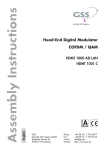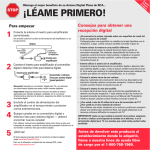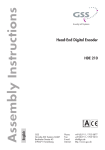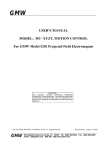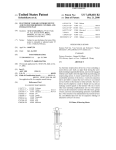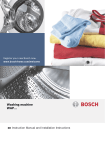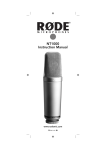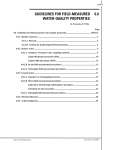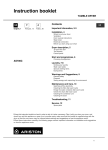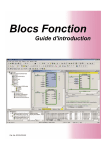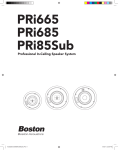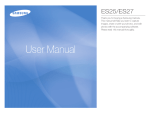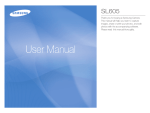Download Manual - gss.de
Transcript
Head-End Digital Modulator HDTV HDTV 1000 ASI LAN KLASSE HDTV 1001 C English CLASS GSS Grundig SAT Systems GmbH Beuthener Strasse 43 D-90471 Nuremberg Phone: Fax: E-mail: Internet: +49 (0) 911 / 703 8877 +49 (0) 911 / 703 9210 [email protected] http://www.gss.de Contents 1 Safety regulations .....................................................................................................4 2 General information .................................................................................................4 2.1 Packing contents ..........................................................................................4 2.2 Meaning of the symbols used ........................................................................5 2.3 Technical data .............................................................................................5 2.4 Description .................................................................................................6 2.4.1 Input signal path “INROUTE” ..............................................................6 Menu setting “A+ASI = 1 B+ASI = 2” ................................................6 Menu setting “A+B+ASI = 1 ASI = 2” ................................................6 Menu setting “A+ASI = 1 A+ASI = 2” ...............................................7 2.4.2 Output signal path “OUTROUTE” ........................................................7 Menu setting “ASI => ASI” .................................................................7 Menu setting “1 => ASI ASI => MA” .................................................7 Menu setting “2 => ASI ASI => MB” .................................................8 2.4.3 General ...........................................................................................8 2.6 How the TPS module works ...........................................................................9 2.7 Explanation of the term “symbol rate” ..........................................................10 3 Assembly ...............................................................................................................11 3.1 Installing the cassette..................................................................................11 3.2 EMC regulations ........................................................................................11 3.3 Connecting the cassette ..............................................................................12 3.4 Retrofitting a CA module ............................................................................13 4 The control panel at a glance ..................................................................................14 4.1 Menu items ...............................................................................................14 4.2 Control panel ............................................................................................14 5 Programming .........................................................................................................15 5.1 Preparation ...............................................................................................15 5.2 Notes on level setting .................................................................................15 5.3 Programming procedure .............................................................................16 Channel strips “A” (without CA module) and “B” ...........................................16 Channel strip “A” with CA module ..............................................................19 5.4 Programming the cassette ..........................................................................20 Selecting the cassette .................................................................................20 Selecting the input signal path .....................................................................21 Selecting the output signal path ...................................................................21 Setting the ASI transfer rate .........................................................................22 Setting the ASI options ...............................................................................22 Selecting the channel strip ..........................................................................23 Selecting channel / frequency setting ...........................................................23 Setting the output channel ...........................................................................24 Setting the output frequency ........................................................................24 Switching the modulator off or on ................................................................25 Adjusting the output levels of the channel strips .............................................25 -2- HDTV 1000 ASI LAN / HDTV 1001 C Setting the LNB oscillator frequency .............................................................26 Setting the input symbol rate .......................................................................26 Setting the DVB mode ................................................................................27 Setting the input frequency ..........................................................................27 Testing the signal to noise ratio ....................................................................28 Setting the station filter ...............................................................................29 Setting the QAM modulation ........................................................................ 32 Inverting the user signal ..............................................................................33 Setting stuffing...........................................................................................33 Setting a substitute signal in the case of an incorrect input signal ....................34 Setting the transport stream ID and the ORGNET-ID .......................................35 Network Information Table (NIT) ..................................................................35 Network/operator identification ..................................................................36 Deleting a PID ...........................................................................................37 Renaming a PID.........................................................................................37 Factory reset .............................................................................................38 Saving settings ..........................................................................................38 5.4.1 Operation with a CA module ............................................................39 Setting the scrambling ......................................................................39 Setting the PID monitoring ................................................................40 Configuring the CA module ..............................................................40 Setting the station filter .....................................................................41 6 Final procedures .....................................................................................................43 7 Channel and frequency tables .................................................................................44 -3- HDTV 1000 ASI LAN / HDTV 1001 C 1 Safety regulations Caution Ê Ê Ê Ê Ê Ê Ê Ê Ê Ê Ê Ê Ê Ê Ê UÊ ÃÃiLÞ]Ê ÃÌ>>ÌÊ >`Ê ÃiÀÛV}Ê Ã Õ`Ê LiÊ V>ÀÀi`Ê ÕÌÊ LÞÊ >ÕÌ ÀÃi`Ê iiVÌÀV>ð UÊ -ÜÌV ÊvvÊÌ iÊ«iÀ>Ì}ÊÛÌ>}iÊvÊÌ iÊÃÞÃÌiÊLivÀiÊLi}}ÊÜÌ Ê>ÃÃiLÞÊÀÊÃiÀÛViÊÜÀÊÀÊ«ÕÊÕÌÊÌ iÊ>ÃÊ«Õ}° UÊ ÊÌÊ«iÀvÀÊÃÌ>>ÌÊ>`ÊÃiÀÛViÊÜÀÊ`ÕÀ}ÊÌ Õ`iÀÃÌÀð UÊ ÃÌ>ÊÌ iÊÃÞÃÌiÊÃÊÌÊÜÊÌÊLiÊ>LiÊÌÊÛLÀ>Ìio Ê Ê>Ê`ÕÃÌvÀii]Ê`ÀÞÊiÛÀiÌ -ÊÊ ÊÃÕV Ê>Ê>iÀÊÌ >ÌÊÌÊÃÊ«ÀÌiVÌi`ÊvÀÊÃÌÕÀi]ÊvÕiÃ]Êë>à }ÊÜ>ÌiÀÊ>`Ê `>«iÃÃ Ê ÃiÜ iÀiÊ«ÀÌiVÌi`ÊvÀÊ`ÀiVÌÊÃÕ} Ì Ê ÌÊÜÌ ÊÌ iÊi`>ÌiÊÛVÌÞÊvÊ i>ÌÊÃÕÀViÃ Ê Ê>Ê>LiÌÊÌi«iÀ>ÌÕÀiÊvÊäÊc ÊÌʳxäÊc °ÊÊV>ÃiÊvÊÌ iÊvÀ>ÌÊvÊ V`iÃ>ÌÊÜ>ÌÊÕÌÊÌ iÊÃÞÃÌiÊÃÊV«iÌiÞÊ`Ài`° UÊ ÃÕÀiÊÌ >ÌÊÌ iÊ i>`i`ÊÃÌ>ÌÊÃÊ>`iµÕ>ÌiÞÊÛiÌ>Ìi`°Ê Ê ÊÌÊVÛiÀÊÌ iÊÛiÌ>ÌÊÃÌð UÊ iÜ>ÀiÊvÊà ÀÌÊVÀVÕÌÃÊ UÊ Ê>LÌÞÊÃÊ>VVi«Ìi`ÊvÀÊ>ÞÊ`>>}iÊV>ÕÃi`ÊLÞÊv>ÕÌÞÊViVÌÃÊÀÊ >««À«À>ÌiÊ >`}° UÊ "LÃiÀÛiÊÌ iÊÀiiÛ>ÌÊÃÌ>`>À`Ã]ÊÀi}Õ>ÌÃÊ>`Ê}Õ`iiÃÊÊÌ iÊÃÌ>>ÌÊ>`Ê «iÀ>ÌÊvÊ>Ìi>ÊÃÞÃÌið UÊ / iÊ ÃÌ>`>À`ÃÊ É É Ê ÊxäänÎÊ >`Ê É É Ê ÊÈäÇÓnÊ ÕÃÌÊ LiÊ LÃiÀÛi`° U For further information please read the assembly instructions for the headend station used. Take action to prevent static discharge when working on the device. 2 General information 2.1 Packing contents Ê Ê Ê Ê £Ê >ÃÃiÌÌiÊ/6Ê£äääÊ-Ê ÊÀÊ/6Ê£ää£Ê ÓÊ ÊV>Lià £Ê Ê>ÃÃiLÞÊÃÌÀÕVÌî £Ê ÀivÊ>ÃÃiLÞÊÃÌÀÕVÌà -4- HDTV 1000 ASI LAN / HDTV 1001 C 2.2 Meaning of the symbols used Important note —> General note Ê UÊ Ê *iÀvÀ}ÊÜÀà 2.3 Technical data Ê The devices meet the following EU directives: ÓääÈÉxÉ ]ÊÓää{É£änÉ The product fulfils the guidelines and standards for CE labelling. Unless otherwise noted all values are specified as “typical”. HF input Frequency range: ......................................................... ÓxÊoÊÓ£xäÊâ Level range: .............................................................ÈäÊ`6ÊoÊnäÊ`6 DVB-S modes: ..............................................DVB-S 1/2 ]Ê2/3 ]Ê3/4 ]Ê5/6 ]Ê7/8 DVB-S2 modes: ......................QPSK 1/2 ]Ê3/5 ]Ê2/3 ]Ê3/4 ]Ê4/5 ]Ê5/6 ]Ê8/9 ]Ê9/10 8PSK 3/5 ]Ê2/3 ]Ê3/4 ]Ê5/6 ]Ê8/9 ]Ê9/10 Symbol rate DVB-S: ...........................................+*-\ÊÊ ÓÊoÊ{xÊ-ÞLÉà Symbol rate DVB-S2: ......................................... +*-\Ê£äÊoÊÎäÊ-ÞLÉÃ Ê n*-\Ê£äÊoÊΣÊ-ÞLÉà HF output Channels: .............................................................................-Ó£ÊoÊ È Frequency range: ............................................... {Ó°äÊâÊoÊnÈä°äÊâÊ Output level: ............................................................................. 97 dBµV Output impedance: ......................................................................... 75 Connections SAT inputs: ............................................................................. 2 F sockets HF output:............................................................................ 1 IEC socket ASI input: .................................................................£Ê ÊÃViÌ]ÊÇxÊ ASI output: ................................................................£Ê ÊÃViÌ]ÊÇxÊ Connection strip (10-pin): ...................for supply voltages and control circuits RS-232 socket: ..................................... serial interface for software update Conditional access: ................................ several channels can be decoded. -5- HDTV 1000 ASI LAN / HDTV 1001 C 2.4 Description Ê / iÊ`ÕLiÊÌÀ>Ã`Õ>ÌÀÊV>ÃÃiÌÌiÊÃÊ>Ê+*-VÛiÀÌiÀ]ÊÜ V ÊVÛiÀÌÃÊ>Ê stations modulated according to DVB-S / DVB-S2 standard into two QAMmodulated cable signals. The cassette has two digital SAT IF inputs and one HF output. Additionally it is equipped with an ASI input and an ASI output (ASI – Asynchronous Serial Interface acc. DIN EN 50083-9). The transport stream fed via the ASI socket can be inserted into the transport streams of the receiving stages via the TPS module. The signal path is set in the menu items input signal path “INROUTE” and output signal path ”OUTROUTE”. 2.4.1 Input signal path “INROUTE” Menu setting “A+ASI = 1 B+ASI = 2” The transport streams of the receiving stage “TS A” and of the ASI input “TS ASI” generate the transport stream 1. The transport streams of the receiving stage “TS B” and of the ASI input “TS ASI” generate the transport stream 2. SAT input ”A“ Receiving stage "A" TS A CA module TPS Transport stream 1 TPS Transport stream 2 TS ASI ASI input SAT input ”B“ Receiving stage "B" TS B Menu setting “A+B+ASI = 1 ASI = 2” The transport streams of the receiving stages “TS A” and “TS B” and of the ASI input “TS ASI” generate the transport stream 1. The “TS ASI” transport stream fed via the ASI input generates the transport stream 2. SAT input ”A“ Receiving stage "A" SAT input ”B“ Receiving stage "B" TS A CA module TS B TPS TS ASI Transport stream 1 Transport stream 2 ASI input -6- HDTV 1000 ASI LAN / HDTV 1001 C Menu setting “A+ASI = 1 A+ASI = 2” The transport streams of the receiving stage “A” “TS A” and of the ASI input “TS ASI” are split into transport stream 1 and 2. Receiving stage “B” is not used. SAT input ”A“ Receiving stage "A" TS A CA module TPS Transport stream 1 TPS Transport stream 2 TS ASI ASI input 2.4.2 Output signal path “OUTROUTE” Menu setting “ASI => ASI” Transport stream 1 is made available via modulator “A»]ÊÌÀ>ëÀÌÊÃÌÀi>ÊÓÊÛ>Ê modulator “B” and the transport stream from the ASI input “TS ASI” via the ASI output. Transport stream 1 Modulator "A" Transport stream 2 Modulator "B" Combiner ASI input Menu setting “1 => ASI Ê TS ASI HF output ASI output ASI => MA” /À>ëÀÌÊÃÌÀi>Ê£ÊÃÊ>`iÊ>Û>>LiÊÛ>ÊÌ iÊ-ÊÕÌ«ÕÌ]ÊÌÀ>ëÀÌÊÃÌÀi>ÊÓÊ via modulator “B” and the transport stream from the ASI input “TS ASI” via modulator “A” (MA). Transport stream 1 ASI input ASI output TS ASI Modulator "A" Combiner Transport stream 2 HF output Modulator "B" -7- HDTV 1000 ASI LAN / HDTV 1001 C Menu setting “2 => ASI ASI => MB” Transport stream 1 is made available via modulator “A»]ÊÌÀ>ëÀÌÊÃÌÀi>ÊÓÊ via the ASI output and the transport stream from the ASI input “TS ASI” via modulator “B” (MB). Modulator "A" Transport stream 1 Combiner ASI input TS ASI HF output Modulator "B" Transport stream 2 ASI output 2.4.3 General Ê The cassette is equipped with two channel strips (“A” and “B”). The chaniÊÃÌÀ«ÃÊVÃÃÌÊvÊÌ iÊ`}Ì>ÊÌÕiÀÃ]ÊÌ iÊ`}Ì>ÊÃ}>Ê«Ài«>À>ÌÊÕÌÃÊ>`Ê the output converter. The channel strips are indicated in the head-end station display with “Bx …A” and “Bx …B”. Using an adequate CA module scrambled channels can be descrambled via channel strip “A”. In addition cassette HDTV 1001 C is able to scramble unscrambled channels via an adequate CA module. The control of the cassette takes place via the control unit of the head-end station. Two LEDs indicate if the respective channel strip is switched on (LED illumi>ÌiîÊÀÊvv]Ê>`Ê>ÃÊ«ÀÛ`iÊ>Ê`V>ÌÊvÊÌ iÊÃ}>ʵÕ>ÌÞÊL>Ãi`ÊÊ their colour. Additionally the quality of the transport stream received is displayed (“CN…”). The integrated TPS module (Transport Stream Processing) processes the data from the demodulated transport streams. The HF output signals are sent through the HF output of the cassette to the output collector. The common output level of the channel strips can be set at the output collector. Additionally a transport stream is made available via the ASI output dependent on the signal path set. 7 iÊÌ iÊ i>`i`ÊÃÌ>ÌÊÃÊÃÜÌV i`Ê]ÊÌ iÊÌÜiÊ Ê`ë>ÞÊà ÜÃÊÌ iÊ software version of the control unit. To operate this cassette the software version of the control unit must be “V 41” or higher. You can find the current operating software for the control unit and Ì iÊV>ÃÃiÌÌi]ÊÌ iÊÃvÌÜ>ÀiʺBE-Flash” and the current assembly instructions on the website “www.gss.de”. The cassette is designed for use in the following head-end stations: STC 1200]ÊSTC 316] STR 19-8 and PST 19-1 -8- HDTV 1000 ASI LAN / HDTV 1001 C 2.5 Ê Ê Software query Control unit vÊ iViÃÃ>ÀÞ]Ê ÞÕÊ V>Ê >VÌÛ>ÌiÊ Ì iÊ `V>ÌÊ vÊ Ì iÊ ÃvÌÜ>ÀiÊ ÛiÀÃÊ vÊ Ì iÊ control unit manually: UÊ *ÀiÃÃÊ>ÞÊÌÜÊiÞÃÊÊÌ iÊVÌÀÊÕÌÊvÊÌ iÊ i>`i`ÊÃÌ>ÌÊÃÕÌ>iÕÃÞÊ ÕÌÊÌ iÊ`ë>ÞÊ}iÃÊ`>ÀÊ>`ÊÌ iÊÃvÌÜ>ÀiÊÛiÀÃ]Êi°}°ÊºV 41” appears. 2.6 How the TPS module works Ê vÌiÀÊ `iV`}Ê +*-Ê ÀÊ n*-`Õ>Ìi`Ê Ã}>Ã]Ê Ì iÊ `i`Õ>Ìi`Ê `>Ì>Ê ÃÌÀi>Ê V>Ê LiÊ >VViÃÃi`Ê Û>Ê Ì iÊ Ìi}À>Ìi`Ê /*-Ê `Õi°Ê / ÃÊ `>Ì>Ê ÃÌÀi>]Ê >ÃÊV>i`ÊÌÀ>ëÀÌÊÃÌÀi>]ÊVÌ>ÃÊÃiÛiÀ>ÊÃÌ>ÌÃÊÊ>ÊÌ iÀÊV«iÌÃÊ Û`i]Ê>Õ`]Ê`>Ì>Ê>`ÊÃiÀÛViÊvÀ>Ì®]ÊÜ V ÊV>ÊLiÊV >}i`ÊÕÃ}ÊÌ iÊ TPS module. Ê Ê Station filter `Û`Õ>Ê ÃÌ>ÌÃÊ V>Ê LiÊ `iiÌi`°Ê / ÃÊ Ài`ÕViÃÊ Ì iÊ `>Ì>Ê À>ÌiÊ >`]Ê VÃiµÕiÌÞ]ÊÌ iÊÕÌ«ÕÌÊÃÞLÊÀ>ÌiÊÀiµÕÀi`°Ê``Ì>ÞÊÃÌ>ÌÃÊvÊÌ iÊ`vviÀiÌÊ transport streams can be assembled to a new transport stream. Stuffing / iÊÌÀ>ëÀÌÊÃÌÀi>ÊÃÊ«>``i`ÊÕÃ}ÊÜ >ÌÊÃÊÜÊ>ÃÊâiÀÊ`>Ì>°Ê/ ÃÊiÃÕÀiÃÊ a steady and constant output symbol rate. Changing the Transport stream and ORGNET-ID The transport stream ID can be changed. If the stations of a transponder are ëÌÊÌÊÌ iÊÌÀ>ëÀÌÊÃÌÀi>ÃÊvÊÌ iÊV >iÊÃÌÀ«ÃÊ»»Ê>`Ê»»]ÊiÊvÊÌ iÊLÌ Ê transport streams a new identification must be allocated to realise the channel search of the settop boxes connected without mistakes. If the ORGNET-ID is changed a new NIT must be generated. Changing the NIT The transport stream contains data in the form of tables which the receivers evaluate and require for convenient use. The TPS module can adjust the “Network Information Table” (NIT) to accommodate the new station data. The “NIT” contains data which is required by the set-top box for the automatic search feature. -9- HDTV 1000 ASI LAN / HDTV 1001 C Changing the operator ID (CAT) Some network operators transmit an operator ID in the data stream (e.g. visAvision). By changing the CAT the operator ID can be adjusted to the demands. 2.7 Explanation of the term “symbol rate” Modulation schemes such as QPSK and QAM transmit multiple bits simultaneously. These are referred to as symbols. In addition to the user data flow which ÌÀ>ÃÌÃÊ Û`iÊ >`Ê >Õ`Ê vÀ>Ì]Ê iÀÀÀÊ VÀÀiVÌÊ LÌÃÊ >ÀiÊ ÌÀ>ÃviÀÀi`°Ê The FEC number states the ratio of user bits to the complete transmitted bits. The output symbol rate is calculated as follows: 256-QAM: SR (A) = FEC x 1/4 x SR (E) 128-QAM: SR (A) = FEC x 2/7 x SR (E) 64-QAM: SR (A) = FEC x 1/3 x SR (E) 32-QAM: SR (A) = FEC x 2/5 x SR (E) 16-QAM: SR (A) = FEC x 1/2 x SR (E) 4-QAM: SR (A) = FEC x 1/1 x SR (E) Ê Ê Example: "ÕÌ«ÕÌÊÃÞLÊÀ>ÌiÊÈ{+] FEC= 3/4] «ÕÌÊÃÞLÊÀ>ÌiÊ-,Ê®ÊrÊÓÇ]xääÊkSymb/s SR (A) = 3/4 x 1/3ÊÝÊÓÇ]xääÊkSymb/s = 6,875 kSymb/s Ê Note: vÊʺ »ÊÃÊÃÌ>Ìi`ÊÊÌ iÊÃÌ>ÌÊÃÌÃ]ÊÌÊV>ÊLiÊ>ÃÃÕi`ÊÌÊLiʺ ÊrÊ3/4”. Reception from a transponder with a very low symbol rate (SCPC station) The extremely low data rate means that the output symbol rate is very low. If Ì iÀiÊ>ÀiÊÀiVi«ÌÊ«ÀLiÃÊÜÌ Ê`vviÀiÌÊ`}Ì>ÊÀiViÛiÀÃ]ÊÃiÌÊÕÌ«ÕÌÊÃÞLÊ rate to a higher value. Ê Defined symbol rates -iÊV>LiÊ«iÀ>ÌÀÃÊëiVvÞÊ>ÊvÝi`ÊÃÞLÊÀ>ÌiÊi°}°ÊÈ]ääÊ-ÞLÉî°Ê - 10 - HDTV 1000 ASI LAN / HDTV 1001 C 3 Assembly 3.1 Installing the cassette – Ensure the head-end station is mounted so it will not be able to vibrate. Û`]ÊvÀÊiÝ>«i]ÊÕÌ}ÊÌ iÊ i>`i`ÊÃÌ>ÌÊÌÊ>ÊvÌÊà >vÌÊÀÊ>ÞÊ other wall or floor construction that vibrates in a similar way. – Before installing or changing a cassette unplug the power cable from the mains power socket. Ê UÊ ,iÛiÊÌ iÊv>ÃÌi}ÊÃVÀiÜÃÊ1 of an unoccupied slot from the bracket of the head-end station. UÊ ÃiÀÌÊÌ iÊV>ÃÃiÌÌiÊÊÌ ÃÊÃÌÊ>`Ê«Õà ÊÌÊÌÊÌ iÊ ÕÃ}° UÊ }ÊÌ iÊV>ÃÃiÌÌiÊ>`Ê>««ÞÊÃ} ÌÊ«ÀiÃÃÕÀiÊÌÊViVÌÊÌÊÌÊÌ iÊViVÌÃÊ of the board and the HF bus bar. UÊ >ÃÌiÊÌ iÊV>ÃÃiÌÌiÊÜÌ ÊÌ iÊÃVÀiÜÃÊ1. Ê Ê Ê ACHTUNG! Vor dem Cassettenwechsel unbedingt Netzstecker ziehen! CASSETTE CASSETTE CASSETTE CASSETTE CASSETTE CASSETTE CASSETTE CASSETTE CASSETTE CASSETTE CASSETTE CASSETTE 0° MESSAUSGANG CAUTION! Before changing cassettes remove mains plug! A 3.2 EMC regulations KLASSE To comply with the current EMC regulations, it is necessary to connect the lines leading in and out of the head-end station using cable terminals. CLASS The attenuation of shielding of the connection lines for ASI and antenna must meet the requirements for “Class A”. When mounting the cassette in a STR 19-8 or PST 19-1 head-end station which is installed in a 19" cabinet, make sure the connections leading in and out for the 19" cabinet are made using cable terminals. - 11 - HDTV 1000 ASI LAN / HDTV 1001 C Ê UÊ ÃiÀÌÊÌ iÊÀiµÕÀi`ÊÕLiÀÊvÊV>LiÊÌiÀ>ÃÊÊÌ iÊ«i}ÃÊ«ÀÛ`i`ÊÊ the head-end station or in the 19" cabinet. —> Cable terminals are not included in the scope of delivery. Tighten the nut on the cable terminal until the teeth on the lock washer have penetrated the exterior coating and a good connection is made between the housing and cable terminal. 3.3 Ê Ê Ê Connecting the cassette SAT input "A" ASI input 2 4 Slot for a CA module SAT input "B" LAN ASI output 1 3 5 6 RS232 7 UÊ Plug the SAT input cables into the SAT input sockets “SAT input A” 2 (channel strip “A”) and “SAT input B” 1 (channel strip “B”). —> LAN socket 3 (intended for additional functions) UÊ iVÌÊÌ iÊ-ÊÃViÌÃÊ4 and 5. U Connect the head-end station to the mains power supply. Slot for a CA module 6 “RS-232“ socket 7 The operating software of the cassette can be updated via the 9-Pin D-SUB socket “RS232” using a PC or notebook and the software “BE-Flash”. You can find the current operating software on the website “www.gss.de”. - 12 - HDTV 1000 ASI LAN / HDTV 1001 C 3.4 Retrofitting a CA module The cassette is equipped with a common interface. It allows you to connect a CA module for various scrambling systems and service providers. Scrambled channels can only be descrambled with a CA module suitable for the scrambling system and the corresponding smart card. The smart card contains all the vÀ>ÌÊvÀÊ>ÕÌ ÀÃ>Ì]Ê`iÃVÀ>L}Ê>`ÊÃÕLÃVÀ«Ì° Ê Ê Ê Ê Caution – Check with the distributor or manufacturer of the CA module to be used to ensure that it is suitable for descrambling several channels. – The hardware and software of this cassette have been thoroughly prepared and tested. – Any changes made by programme providers to the structures in the programme data might impair or even prevent this function. qÊ 7 iÊÜÀ}ÊÜÌ ÊÌ iÊ Ê`Õi]Ê«i>ÃiÊÀi>`ÊÌ iÊVÀÀië`}Ê«iÀ>Ìing manual from the respective provider. UÊ ÃiÀÌÊÌ iÊÃ>ÀÌÊV>À` into the CA module so that the chip on the smart card faces the thicker side (top) of the CA module. UÊ ÃiÀÌÊÌ iÊ Ê`ÕiÊÌÊÌ iÊÃÌ 6 (see chap. 3.3) with the top side of the CA module facing the top side of the cassette. UÊ *Õà ÊÌ iÊ Ê`ÕiÊÜÌ ÕÌÊV>Ì}ÊÌÊÌ iÊ}Õ`iÊÀ>ÃÊvÊÌ iÊ ÊÃÌÊ 6 and contact it to the common interface. - 13 - HDTV 1000 ASI LAN / HDTV 1001 C 4 The control panel at a glance 4.1 Menu items Programme the cassette using the buttons on the control unit of the head-end station. The two-line display of the control unit then shows the menus. The parameters and functions to be set are underlined. Use the key to select the following main menu items: – Input signal path – Output signal path BE-Remote V41 – Channel strip please wait . . . – Selecting channel / frequency setting – Output channel / output frequency – Output level – LNB oscillator frequency – Input symbol rate – Input frequency – Station filter – QAM modulation – Stuffing – Substitute signal – Transport stream and ORGNET-ID – Network Information Table (NIT) – Network/operator identification – Deleting a PID – Renaming a PID – Factory reset 4.2 Control panel The key pad on the head-end station is used to scroll through the menus and menu items one at a time: scrolls forward through the menus. select parameters in the menus. ÃiÌÊÛ>ÕiÃ]ÊÌ>ÌiÊ>VÌð selects sub-menus. scrolls backward through the menus. saves all entries (in menu “DEFAULT” -> Factory reset). - 14 - HDTV 1000 ASI LAN / HDTV 1001 C 5 Programming 5.1 Preparation Ê UÊ iVÌÊÌ iÊÌiÃÌÊÀiViÛiÀÊÌÊÌ iÊÊÕÌ«ÕÌÊÀÊÌ iÊÌiÃÌÊÕÌ«ÕÌÊvÊÌ iÊ i>`i`Ê station. UÊ -iÌÊÌ iÊÕÌ«ÕÌÊV >iÊÉÊÕÌ«ÕÌÊvÀiµÕiVÞÊvÊÌ iÊcassette (see page 23) and adjust the TV test receiver to this channel. UÊ Switch on the channel strip (modulator) if necessary (see page 25). For each V >iÊ ÃÌÀ«]Ê Ì iÀiÊ ÃÊ >Ê ÃÌ>ÌÕÃÊ Ê Ü V Ê `V>ÌiÃÊ vÊ Ì iÊ V >iÊ ÃÌÀ«Ê ÃÊ switched on. Ê Ê Status LED Channel strip "B" Status LED Channel strip "A" Ê UÊ >>ViÊÌ iÊÕÌ«ÕÌÊiÛiÃÊvÊÌ iÊV >iÊÃÌÀ«ÃʺA” and “B” if the difference in level is 1 dB (page 25). 5.2 Notes on level setting In order to prevent interference within the head-end station and the cable sysÌi]ÊÌ iÊÕÌ«ÕÌÊiÛiÊvÊÌ iÊV>ÃÃiÌÌiÊÕÃÌÊLiÊ`iVÀi>Ãi`ÊLÞÊ£äÊ`ÊV«>Ài`ÊÌÊ >>}ÕiÊV>ÃÃiÌÌiÃÊ>ÌÊÈ{Ê+]Ê>`ÊLÞÊ{Ê`ÊV«>Ài`ÊÌÊ>>}ÕiÊV>ÃÃiÌÌiÃÊ at 256 QAM. Ê UÊ i>ÃÕÀiÊÌ iÊÕÌ«ÕÌÊiÛiÃÊvÊÌ iÊÌ iÀÊV>ÃÃiÌÌiÃÊ>`ÊÌÕiÊÌ iÊÌÊ>ÊÕvÀÊ output level using the appropriate level controls or software dependent on the head-end station used. Please regard the assembly instructions of the respective head-end station. - 15 - HDTV 1000 ASI LAN / HDTV 1001 C 5.3 Programming procedure Channel strips “A” (without CA module) and “B” Ein / On BE–Remote V 41 please wait … t > 10 s Bx 1A TWIN-SAT C5-12,S3-24 C07 + Box 4 Bx 1A TWIN-SAT Böx 4 TWIN-SAT Bx 5A DVBT-DVBT C5-12,S3-24 C07 C5-12,S3-24 C07 BD3 C09 DVBS2-TPM V 12 – – – A Bx 4 INROUTE A+B+ASI=1 ASI=2 M M Bx 4 1=>ASI Page 18 A+ASI=1 B+ASI=2 / A+B+ASI=1 ASI=2 / A+ASI=1 A+ASI=2 M Bx 4 OUTROUTE ASI RATE Ï/Å 108000 KBits ASI=>MA 1=>ASI ASI=>MA 2=>ASI ASI=>MB ASI=>ASI Bx 4 ASI OPTION Ï / Å 188 / 204 positive / negativ continuous / burst 188 pos. cont. M B Bx 4 LINE Line A <= => Line B Page 18 Ï/Å Line A / Line B M Bx 4A OUTPUT Channel Channel / Freq. M Bx 4A S21 OUTPUT on Ï/Å on / off M Bx 4A LEVEL 0 dB 0 … -10 dB M Bx 4A - 16 LNB Ï/Å HDTV 1000 ASI LAN / HDTV 1001 C on / off M Bx 4A LEVEL 0 dB 0 … -10 dB M LNB Ï/Å SYMBOL Ï/Å Bx 4A 10600 MHz M Ï/Å Bx 4A 27500 DVB-S DVB-S / DVB-S 2 … M Ï/Å Bx 4A 11835 -0.6 FREQ Bx 4A CN 14 12.0 dB C/N (+ 9.6) OK Anzeige: Signalqualität Display: Signal quality M Bx 4A PROGRAM Filter off M Å Bx 4A TV + Programme entfernen / hinzufügen Removing / activating stations 01/10 Das Erste Ï/Å nächster Service (Programm) next service (station) M M M ohne CA-Modul without CA module Kanalzug “B” Channel strip “B“ ASI QAM 64-QAM Programme entfernen / hinzufügen Removing / activating stations 02/19 SWF3 Ï/Å TV + . . . . . Kanalzug “A” mit CA-Modul Channel strip “A“ with CA module Bx 4A 4 … 256 Bx 4B TV + nächster Service (Programm) next service (station) Programme entfernen / hinzufügen Removing / activating stations 01/10 Ï/Å nächster Service (Programm) next service (station) C Page 19 D Ï/Å normal / inverse normal M Bx 4A STUFFING Ï/Å SR=6900 (6325) M Bx 4A FAILURE Null Packets Null Packets … Single Carrier M Bx 4A 0x0001,0100 TS/ONID Ï/Å off on / off - 17 - HDTV 1000 ASI LAN / HDTV 1001 C M Bx 4A FAILURE Null Packets Null Packets … Single Carrier M Bx 4A TS/ONID 0x0001,0100 Ï/Å off on / off M Bx 4A on / off off NIT => Make Å Make M Ï/Å Bx 4A CAT-ID 0XDE00 Ï/Å off on / off M Ï/Å Bx 4A DROP PID 0x0000 Ï/Å off on / off M Ï/Å Bx 4A REMAP 0x0000 –> 0000 Ï/Å off on / off Page 16 M Bx 4A Defaults FACTORY => Bx 4A Å FACTORY STORE => M A auf Werkseinstellung zurücksetzen und speichern M reset to factory defaults Page 16 and store B M - 18 - HDTV 1000 ASI LAN / HDTV 1001 C Channel strip “A” with CA module Page 17 C Bx 4A CA scramble scramble only HDTV 1001 C descramble Bx 4A CA PID Check on Bx 4A M => Edit X / 0 Ï Å Bx 4A TV X 04/09 . . . . Information *) *) on / off CA Menu <= Bx 4A 01/03 MENU scramble / descramble X – 0 – entschlüsseln descrambling nicht entschlüsseln no descrambling Ï/Å Die angezeigte Information ist abhängig vom verwendeten CA-Modul. The information displayed is dependent on the CA module used. nächster Service next service D Page 17 - 19 - HDTV 1000 ASI LAN / HDTV 1001 C 5.4 Programming the cassette —> Pressing the button for longer than 2 seconds cancels the programming procedure. This takes you back to the programme item “Selecting the cassette” from any menu. Any entries that have not been saved are reset to the previous settings. —> Entries in the menus can be saved by pressing the key. You are taken back to the “Selecting the cassette” menu item. Ê UÊ -ÜÌV ÊÊÌ iÊ i>`i`ÊÃÌ>Ì —> The display shows the software version (e.g. V 41) —> The processor reads the cassettes‘ data (approximately 10 seconds). Ein / On BE–Remote V 41 please wait … t > 10 s Selecting the cassette Bx 1A TWIN-SAT C5-12,S3-24 C07 + Box 4 V 12 Bx 1A TWIN-SAT Böx 4 TWIN-SAT Bx 5A DVBT-DVBT C5-12,S3-24 C07 C5-12,S3-24 C07 BD3 C09 DVBS2-TPM – – – A Ê UÊ -iiVÌÊÌ iÊcassette you want to programme (e.g. Box 4) by repeatedly pressing the button if necessary. —> The display shows e.g. the menu : Box 4 DVBS2-TPM V12 “Box 4” stands for slot 4 ”DVBS2-TPM” Type of cassette ”V 12” Software version of the cassette Ê UÊ *ÀiÃÃÊÌ iÊ button. —> The “Selecting the input signal path” – “INROUTE” menu is activated. - 20 - HDTV 1000 ASI LAN / HDTV 1001 C Selecting the input signal path In this menu you define the signal path of the input transport streams. Menu setting “A+ASI = 1 B+ASI = 2” (page 6). Menu setting “A+B+ASI = 1 ASI = 2” (page 6). Menu setting “A+ASI = 1 A+ASI = 2” (page 7). Bx 4 INROUTE A+B+ASI=1 ASI=2 M A+ASI=1 B+ASI=2 / A+B+ASI=1 ASI=2 / A+ASI=1 A+ASI=2 M Ê UÊ 1ÃiÊÌ iÊ buttons to select the signal path wished. Ê UÊ *ÀiÃÃÊÌ iÊ button. —> The “Selecting the output signal path” – “OUTROUTE” menu is activated. Selecting the output signal path In this menu you define the signal path of the output transport streams. Menu setting “ASI => ASI” (page 7). Menu setting “1 => ASI ASI => MA” (page 7). Menu setting “2 => ASI ASI => MB” (page 8). M Bx 4 Bx 4 OUTROUTE 1=>ASI ASI RATE Ï/Å 108000 KBits ASI=>MA 1=>ASI ASI=>MA 2=>ASI ASI=>MB ASI=>ASI Bx 4 ASI OPTION buttons to select the signal path wished. / 188 / 204 Ê UÊ 1ÃiÊÌ iÊ Ê UÊ vÊÞÕÊ`ÊÌÊÜ>ÌÊÌÊ`Ê-ÊÃiÌÌ}Ã]Ê«ÀiÃÃÊÌ iÊ button. —> The “Selecting the channel strip” – “LINE” menu is activated (page 23). Ê UÊ *ÀiÃÃÊÌ iÊ button. —> The “Setting the ASI transfer rate” – “ASI RATE” menu is activated. - 21 - HDTV 1000 ASI LAN / HDTV 1001 C Setting the ASI transfer rate In this menu you set the transfer rate for the ASI component connected. For this setting please take the required information from the documentation (technical data) of the ASI component to be connected. M Bx 4 Bx 4 OUTROUTE 1=>ASI ASI RATE Ï/Å 108000 KBits ASI=>MA 1=>ASI ASI=>MA 2=>ASI ASI=>MB ASI=>ASI Bx 4 ASI OPTION / 188 / 204 Ê UÊ 1ÃiÊÌ i buttons to place the cursor under the digits to be set for the transfer rate then use the buttons to set the transfer rate wished. Ê UÊ *ÀiÃÃÊÌ iÊ button. —> The “Setting the ASI options” – “ASI OPTION” menu is activated. Setting the ASI options Ê ÊÌ ÃÊiÕÊÞÕÊ`iviÊÌ iÊÃâiÊvÊÌ iÊ`>Ì>Ê«>ViÌÃ]ÊÌ iÀÊ«>ÀÌÞÊ>`ÊÌ iÊÌÞ«iÊ of transmission. For this setting please take the required information from the documentation (technical data) of the ASI component to be connected. ASI=>ASI Bx 4 ASI OPTION 188 pos. cont. Ï / Å 188 / 204 positive / negativ continuous / burs M Ê UÊ *ÀiÃÃÊÌ iÊ bits). ÊLÕÌÌÃÊÌÊÃiÌÊÌ iÊÃâiÊvÊÌ iÊ`>Ì>Ê«>ViÌÃʺ188” or “204” Ê UÊ vÊÌ iÊ«>ÀÌÞÊvÊÌ iÊ`>Ì>ÊÌÊLiÊÌÀ>ÃÌÌi`Ê >ÃÊÌÊLiÊV >}i`]Ê«ÀiÃÃÊÌ i buttons to place the cursor under “pos.” (positive – standard) and using the buttons set to “neg.” (negative). Ê UÊ /ÊV >}iÊÌ iÊÌÞ«iÊvÊÌÀ>ÃÃÃÊ«ÀiÃÃÊÌ i buttons to position the cursor under “cont.” (continuous – standard) and using the set to “burst”. - 22 - HDTV 1000 ASI LAN / HDTV 1001 C Bx 4 —> INROUTE Setting A+B+ASI=1 “cont.” A+ASI=1 B+ASI=2 / M A+B+ASI=1 ASI=2 / A+ASI=2 userA+ASI=1 data are collected to ASI=2 The dataMpackets of the a great data packet in the transport stream. —> Setting “burst” OUTROUTE Bx 4 Bx 4 ASI RATE Ï/Å M The data packetsASI=>MA of the user data are 108000 KBits spaced out evenly in the transport 1=>ASI stream. Ê 1=>ASI ASI=>MA 2=>ASI ASI=>MB ASI=>ASI UÊ *ÀiÃÃÊÌ iÊ button. Bx 4 ASI OPTION Ï/Å —> The “Selecting the channel strip” – “LINE” menu is activated. 188 pos. cont. 188 / 204 positive / negativ continuous / burst M Selecting the channel strip B Bx 4 LINE Line A <= => Line B Ï/Å Line A / Line B M Bx 4A OUTPUT Ê UÊ ÞÊ«ÀiÃÃ} select channel strip “A” (“Line A”) or select channel strip “B” Channel (“Line B”) by pressing the button. Channel / Freq. Ê UÊ *ÀiÃÃÊÌ iÊ button. Bx 4A OUTPUT/ frequency setting” – “OUTPUT” menu is acti—> The “Selecting channel Ï/Å S21 on vated. M on / off M Selecting channel / frequen cy setting Bx 4A LEVEL Ê 0 dB 0 … -10 dB VÞÊÃiÌÌ}ÊvÀÊÌ iÊ>`ÕÃÌiÌÊ ÊÌ ÃÊiÕ]ÊÞÕÊV>ÊÃiiVÌÊÌ iÊV >iÊÀÊvÀiµÕiÊ vÊÌ iÊÊÕÌ«ÕÌ°Ê/ iÊV >iÊÃiÌÌ}ÊVÛiÀÃÊÌ iÊÀ>}iÊvÊV >iÃÊ-Ó£ÊoÊ È]Ê M Ì iÊvÀiµÕiVÞÊÃiÌÌ}ÊVÛiÀÃÊÌ iÊÀ>}iÊvÀÊ{Ó°äÊâÊÌÊnÈä°äÊâ° Bx 4A LNB Ï/Å Ê / iÊ +Ê Ã}>Ê ÃÊ À>ÞÊ ÌÀ>ÃÌÌi`Ê ÜÌ Ê >Ê L>`Ü`Ì Ê vÊ nÊ â°Ê / ÃÊ 10600 MHz means that you can only use the channel centre frequency of the existing M V >iÊ}À`ÊÊÌ iÊÀ>}iÊvÊV >iÃÊ-Ó£ÊoÊ ÈÊvÀiµÕiVÞÊ}À`ÊnÊâ®°Ê / iÊ ,ÊV >iÊ}À`ÊÃÊÇÊâÊÊÌ iÊÀ>}iÊvÊÌ iÊÜiÀÊvÀiµÕiVÞÊL>`ÃÊ Bx 4A SYMBOL Ï/Å Ï/Å V >iÃÊ ÓÊoÊ-Óä®°Ê/ iÀivÀiÊÌ iÊvÀiµÕiVÞÊÃiÌÌ}ÊÃÊÕÃi`Ê iÀi°ÊvÊiÊÕÃiÃÊ 27500 DVB-S DVB-S / DVB-S 2 … Ì iÊiÝÃÌ}ÊV >iÊ}À`ÊvÊÇÊâÊÊÌ iÃiÊV >iÊÀ>}iÃ]ÊÌ ÃÊÜÊÀiÃÕÌÊÊ ÌiÀviÀiViÊÛiÀ>««}®ÊÜÌ ÊÌ iÊnÊâÊ+ÊÃ}>Ê«>V>}iÃ]ÊÌ ÕÃÊV>ÕÃM ing transmission problems. Ï/Å Bx 4A 11835 M -0.6 FREQ Bx 4A CN 14 12.0 dB - 23 - C/N (+ 9.6) OK Anzeige: Signalqualität Display: Signal quality HDTV 1000 ASI LAN / HDTV 1001 C M Bx 4 INROUTE A+ASI=1 B+ASI=2 / A+B+ASI=1 ASI=2 / channel ranges and in A+ASI=1 A+ASI=2 A+B+ASI=1 ASI=2 M For programming in these the frequency ranges below B M Ì i]ÊÜiÊÀiVi`ÊÃÌ>ÀÌ}ÊÜÌ ÊV >iÊ-Ó£ÊÉÊÎäÈÊâÊ}}ÊL>VÊÊ Bx 4 LINE Ï/Å ÃÌi«ÃÊvÊnÊâÊÃiiÊvÀiµÕiVÞÊÌ>LiÊÊ«>}iÊ{{®]ÊÀÊÀi`ÕV}ÊÌ iÊL>`Ü`Ì Ê Line A / Line B Line A <= => Line B Bx 4 OUTROUTE Bx 4 ASI RATE Ï/Å of the MQAM output signal by removing stations. 1=>ASI M ASI=>MA 1=>ASI ASI=>MA 2=>ASI ASI=>MB Bx 4A ASI=>ASI Channel 108000 KBits OUTPUT Channel / Freq. Bx 4 ASI OPTION Ï / Å 188 / 204 positive / negativ continuous / burst 188 pos. cont. M M Bx 4A Ê Ê UÊ 1ÃiÊ OUTPUT S21 to Ï / Å “Channel” or frequency setting “Freq.”. on setting select channel on / off B M LINE UÊ *ÀiÃÃÊÌ iÊ Bx 4 button. Ï/Å Line A / Line B Line A <= —> The “Setting output Bx 4A the=> Line B LEVEL channel” or “Setting the output frequency” – “OUTPUT” menu is activated. 0 dB 0 … -10 dB M M Bx 4A OUTPUT Bx 4A LNB M Bx 4A OUTPUT S21 Bx 4A on SYMBOL Setting the output channel Channel Channel / Freq. Ï/Å In this menu 10600 MHz you set the output channel of the channel strip. Additionally the M modulator of the channel strip can be switched off or on (page 25). Ï/Å 27500 M Ê UÊ Use the Ï/Å M Bx 4A Bx 4A 0 dB 11835 M Ï/Å Ï/Å DVB-S on / off DVB-S / DVB-S 2 … LEVEL buttons to set the output channel. 0 … -10 dB Bx 4A FREQ -0.6 CN 14 Setting the output frequency M Bx 4A LNB 12.0 dB C/N (+ 9.6) OK Anzeige: Signalqualität Display: Signal quality Ï/Å In this menu you set the output frequency of the channel stripÊ {Ó°äÊ oÊ Programme entfernen 10600 MHz M PROGRAM + strip 01/10 can be switched Removing / activating nÈä°äÊâ®.Bx 4A Additionally the modulator of Bx 4A TV the channel Filter off Das Erste Ï / Å nächster Service (Pro off or on (page M 25). Å next service (station) Ï/Å Ï/Å M Bx 4A Bx 4A 466.00 27500 OUTPUT SYMBOL DVB-S on Ï/Å Ï/Å on / off M M Ï/Å Bx 4A 11835 M -0.6 DVB-S / DVB-S 2 … Bx 4B TV + SWF3 Ï/Å FREQ Bx 4A CN 14 ASI + 01/10 12.0 dBTV (+ 9.6) OK M - 24 - Programme entfernen Removing / activating 02/19 C/N nächster Service (Pro next service (station) Anzeige: Signalqualität Programme entfernen Display: Signal quality Removing / activating Ï / Å nächster Service (Pro next service (station) HDTV 1000 ASI LAN / HDTV 1001 C . . . . . Programme entfernen M Bx 4 1=>ASI Ê OUTROUTE Bx 4 ASI=>MA ASI RATE Ï/Å 108000 KBits UÊ 1ÃiÊÌ i buttons to place the cursor under the digit to be set for the 1=>ASI ASI=>MA 2=>ASI ASI=>MB frequency display then use to set the output frequency wished. ASI=>ASI Bx 4 ASI OPTION Ï / Å 188 / 204 188 pos. cont. Switching the modulator off or on positive / negativ continuous / burst M Ê UÊ /ÊÃÜÌV ÊvvÊÌ iÊ`Õ>ÌÀÊ«>ViÊÌ iÊVÕÀÃÀÊÕ`iÀʺon” using the button and switch “off” the modulator of the channel strip using the buttons. —> The switched off modulator is indicated by “ - - - “ in the display. B —> The status LED is switched off (see also page 15). Bx 4 LINE Ï/Å Ê UÊ vÊÌ iÊ`Õ>ÌÀÊÃÊÃÜÌV i`ʺoff” use the Ê UÊ *ÀiÃÃÊÌ iÊ Bx 4A button. OUTPUT —> The “Adjusting the output levels ofChannel / Freq. the channel strips” – “LEVEL” menu is Channel activated. Line A <= => Line B Line A / Line B M to switch it “on”. M OUTPUT Adjusting theBx 4A output levels of the channel strips S21 on Ï/Å This menu item is used to set the output on / off levels of the modulators of the channel strips “A” andM“B” to the same value. Bx 4A LEVEL 0 dB 0 … -10 dB M Bx 4A Ê Ê Ê Ê Ê Ê Ê Ê Ê UÊ LNB Ï/Å 10600 MHz i>ÃÕÀiÊ>`ÊÌiÊ`ÜÊÌ iÊÕÌ«ÕÌÊiÛiÊvÊÌ iÊV >iÊÃÌÀ«°Ê/Ê>`ÕÃÌÊÌ iÊ output level to the output levels of the other cassettes please pay attention M to chapter 6 “Final procedures”. UÊ ÞÊÀi«i>Ìi`ÞÊ«ÀiÃÃ}ÊÌ iÊ button scroll back to the “Selecting the Bx 4A SYMBOL Ï/Å Ï/Å channel strip” menu. 27500 DVB-S DVB-S / DVB-S 2 … UÊ -iiVÌÊÌ iÊÌ iÀÊV >iÊÃÌÀ« (page 23) and set the following menu items: M UÊ º-iiVÌ}ÊV >iÊÉÊvÀiµÕiVÞÊÃiÌÌ}»Ê«>}iÊÓή° UÊ º-iÌÌ}ÊÌ iÊÕÌ«ÕÌÊV >i»ÊÀʺ-iÌÌ}ÊÌ iÊÕÌ«ÕÌÊvÀiµÕiV޻ʫ>}iÊÓ{®° Bx 4A FREQ Bx 4A C/N Ï/Å Anzeige: Signalqualität UÊ -ÜÌV ÊÊÌ iÊ`Õ>ÌÀÊvÊiViÃÃ>ÀÞÊ«>}iÊÓx®° Display: Signal quality 11835 -0.6 CN 14 12.0 dB (+ 9.6) OK UÊ i>ÃÕÀiÊ>`ÊÌiÊ`ÜÊÌ iÊÕÌ«ÕÌÊiÛi° UÊ VÌÛ>ÌiÊÌ iÊ“LEVEL” menu of the channel strip with the higher output level. M UÊ ÞÊ«ÀiÃÃng adjust the higher output level of one channel strip to the Programme entfernen M lower output level of the other channel strip incrementally “–10 Bx 4A PROGRAM Bx 4A TV + 01/10from “0” to Removing / activating nächster Service (Pro dB”. Filter off Das Erste Ï Å / Å next service (station) M - 25 - HDTV 1000 ASI LAN / HDTV 1001 C Programme entfernen Bx 4A Ê S21 on positive / negativ continuous / burst 188 pos. cont. OUTPUT Ï/Å M on / off UÊ *ÀiÃÃÊÌ iÊ button. M —> The “Setting the LNB oscillator frequency” – “LNB” menu is activated. B Setting the Bx 4A LEVEL Bx 4 LINE Ï/Å 0 dB 0 … -10 dB Line A / Line B Line A <= => Line B LNB oscillator frequency M M frequency of the LNB used in this menu. Set the oscillator Bx 4A Bx 4A 10600 MHz Channel LNB OUTPUT Ï/Å Channel / Freq. M M Ê Ê Ê Ï/Å UÊ 1ÃiÊ display. UÊ *ÀiÃÃÊ Bx 4A Ï to placeSYMBOL the cursor Bx 4A OUTPUT 27500 DVB-S Ï S21 on M M Å /under the digit to be set for the frequency DVB-S / DVB-S 2 … /Å on / off to enter the oscillator frequency of the LNB used. UÊ *ÀiÃÃÊÌ iÊ button. Bx 4A FREQ Bx 4A C/N Ï/Å Anzeige: Signalqualität Bx 4A LEVEL Display: Signal quality —> The “Setting symbol rate” – “SYMBOL” menu is activated. 11835 the -0.6input CN 14 12.0 dB (+ 9.6) OK 0 dB 0 … -10 dB M M Setting the input symbol rate Bx 4A PROGRAM Bx 4A LNB rates of the Filter off 10600 MHz satellite M Ï/Å Bx 4A TV + Programme entfernen Removing / activating 01/10 The symbol transponders can be found in theÏcurrent chanDas Erste / Å nächster Service (Pro Å next service (station) iÊ Ì>LiÊ vÊ Ì iÊ Ã>ÌiÌiÊ «iÀ>ÌÀ]Ê Ê Û>ÀÕÃÊ Ã>ÌiÌiÊ >}>âiÃÊ >`Ê Ê Ì iÊ M M Internet. Ï/Å Bx 4A 27500 SYMBOL Ï/Å M DVB-S Bx 4B TV + Programme entfernen Removing / activating 02/19 SWF3 Ï/Å DVB-S / DVB-S 2 … nächster Service (Pro next service (station) M Programme entfernen Ê Ê Ï/Å Bx 4A FREQ M ASI TV + 01/10 Removing / activating Bx 4A C/N Anzeige: Signalqualität . . . . . Ï / Å nächster Service (Pro Display: Signal quality next service (station) 12.0 dB the digit to (+ 9.6) OK be set for the symbol rate 11835 -0.6 CN 14 UÊ 1ÃiÊ to position the cursor under displayed. M UÊ *ÀiÃà to enter the values of the symbol rate. ohne CA-Modul without CA module Bx 4A Kanalzug “B” Filter Channel strip “B“ PROGRAM off M Bx 4A 4 … 256 64-QAM QAM M Bx 4A TV + 01/10 Kanalzug “A” mit CA-Modul Das Erste Channel strip “A“ with CA module Å M STUFFING SR=6900 (6325) Ï/Å nächster Service (Pro next service (station) D Ï/Å normal M Bx 4A Programme entfernen C Removing / activating Ï/Å - 26 M normal / inverse Bx 4B TV + SWF3 Programme entfernen Removing / activating 02/19 Ï/Å nächster Service (Pro next service (station) Programme entfernen HDTV LAN / HDTV 1001 C ASI 1000 TV + ASI01/10 Removing / activating . . . . . Ï Å nächster Service (Pro Setting the DVB mode Ê / iÊV>ÃÃiÌÌiÊÀiV}âiÃÊÌ iÊÌÀ>ÃÌÌi`Ê6Ê`iÊ>`ÊÃÜÌV iÃÊÛiÀÊLiÌÜiiÊ the normal QPSK mode (DVB-S) and the DVB-S2 mode. Receiving stations ÜÌ Ê6-ÓÊ`i]ÊÜiÊÃÕ}}iÃÌÊÌÊ«ÀiÃiÌÊÌ iÊ6Ê`iÊÌÊà ÀÌiÊÌ iÊÌiÊvÀÊ searching stations. Ï/Å Bx 4A 27500 SYMBOL Ï/Å DVB-S DVB-S / DVB-S 2 … M Ê Ê UÊ 1ÃiÊÌ iÊ button to place the cursor under “DVB-S” and set the required DVB-S2-mode with the buttons . UÊ *ÀiÃÃÊÌ iÊ button. —> The “Setting the input frequency” – “FREQ” menu is activated. Setting the input frequency Ê If three dots “ …ʺÊ>««i>ÀÊÊÌ iÊÃiV`ÊiÊvÊÌ iÊ`ë>Þ]ÊÌ iÊV>ÃÃiÌÌiÊÃÊÊ the “station search” mode. Please wait until the process has finished. "ViÊÌ iÊÊÀiViÛiÀÊ >ÃÊÃÞV ÀÃi`ÊÌÊÌ iÊ«ÕÌÊÃ}>]Ê>ÞÊvvÃiÌÊÌÊÌ iÊ Ì>À}iÌÊvÀiµÕiVÞÊÃÊ`ë>Þi`ÊÊâ]Êi°}°Êº– 1.8”. If a question mark “?»Ê>««i>ÀÃÊÊÌ iÊÃiV`ÊiÊvÊÌ iÊ`ë>Þ]ÊÌ iÀiÊÃÊÊ input signal present. Check the configuration of the antenna system and headend station as well as the preceding settings of the cassette. Ï/Å Bx 4A 11835 -0.6 FREQ Bx 4A CN 14 12.0 dB C/N (+ 9.6) OK Anzeige: Signalqualität Display: Signal quality M Ê Ê Ê Ê UÊ 1ÃiÊ to position the cursor under the digit to be set of the frequency displayed. UÊ *ÀiÃÃÊ to set the input frequency. UÊ -iÌÊ Ì iÊ vÀiµÕiVÞÊ vvÃiÌÊ Ã ÜÊ Ê Ì iÊ `ë>ÞÊ (e.g. “– 1.8”) to less than £ÊâÊby varying the input frequency using the buttons. UÊ *ÀiÃÃÊÌ iÊ button. —> The “Testing the signal to noise ratio” – “C/N” menu is activated. - 27 - HDTV 1000 ASI LAN / HDTV 1001 C Testing the signal to noise ratio In this menu you can estimate the quality of the input signal. Ï/Å Bx 4A 11835 -0.6 FREQ Bx 4A CN 14 12.0 dB C/N (+ 9.6) OK Anzeige: Signalqualität Display: Signal quality M C/N Bx 4A 12.0 dB (+ 9.6) OK 1 2 Current signal to noise ratio This value shows the difference between the quality of the input signal and the threshold of the tuner at this type of modulation. At a value lower than “5” picture dropouts can occur. 3 If “OK»ÊÃÊà Ü]ÊÌ iÊÃ}>ÊÌÊÃiÊÀ>ÌÊÃÊ° If a value < 5 is shown under 2 the display changes from “OK” to “??”. In this case test the input signal. —>Ê Ê>``ÌÊÌÊÌ iÊ`V>ÌÀÊÊÌ iÊ`ë>Þ]ÊÌ iÀiÊÃÊ>ÃÊ>ÊÃÌ>ÌÕÃÊÊÜ V Ê indicates the quality of the received transport stream: Status LED Channel strip "A" LED indicator Green Yellow Red Off Status LED Channel strip "B" - 28 - Indication Signal quality is good Signal quality is poor No signal The channel strip (modulator) is switched off HDTV 1000 ASI LAN / HDTV 1001 C Ê UÊ *ÀiÃÃÊÌ iÊ button to return to the main menu. If the input signal path “A+B+ASI=1 ASI=2” is selected the station filter of channel strip “B” is used in the channel strip “A”. Therefore perform the settings for channel strip “B»Ê>VVÀ`}ÊÌÊÌ iÊ«>}iÃÊÓÎÊÉÊÓ{]ÊLivÀiÊ>VÌÛ>Ì}ÊÌ iÊ “Setting the station filter” – “PROGRAM” menu. If the input signal path “A+ASI=1 B+ASI=2” or “A+ASI=1 A+ASI=2” is selected the channel strips can be programmed one after the other. Ê UÊ *ÀiÃÃÊÌ iÊ button. —> The “Setting the station filter” – “PROGRAM” menu is activated. Setting the station filter The default setting for the station filter is “off”. In this menu you define the stations received to be transmitted. If stations are activated the output symbol rate increases. If the station filter is switched off (factory default) all stations of the transport stream passes the station filter. As soon as the station filter is activated all stations are inactive and can be added to the transport stream selectively. The figure of the menu below is dependent on the setting of the “Selecting the input signal path” menu (page 21). The menu shows the setting ”A+B+ASI = 1 ASI = 2”. With this setting the transport stream of channel strip “B” is routed to the transport stream of channel strip “A” and therefore cannot be set in channel strip “B”. Programming channel strip “B” the transport stream coming from the ASI input can be processed only. - 29 - HDTV 1000 ASI LAN / HDTV 1001 C Ï/Å Bx 4A 11835 -0.6 FREQ Bx 4A CN 14 12.0 dB Menu setting ”A+B+ASI = 1 M Channel strip “A” Bx 4A ASI = 2”. PROGRAM Filter off M Å C/N (+ 9.6) OK Bx 4A TV + Anzeige: Signalqualität Display: Signal quality Programme entferne Removing / activatin 01/10 Das Erste Ï/Å nächster Service (Pr next service (station M M M Bx 4B TV + SWF3 ASI Programme entferne Removing / activatin 02/19 Ï/Å TV + Programme entferne Removing / activatin 01/10 . . . . . Ï/Å ohne CA-Modul without CA module —> “Setting the station filter” menu of channel strip “B” Kanalzug “A” mit CA-Modul Kanalzug “B” Channel strip “B“ Bx 4B PROGRAM Bx 4A Filter 4 … 256 64-QAM QAM off . . . . . nächster Service (Pr next service (station C Channel strip “A“ with CA module ASI TV – 01/10 ÏÅ /Å nächster Service (Pr next service (station D Ï/Å normal / inverse normal M Ê Ê Ê Ê UÊ Press the Bx 4A button. STUFFING Ï/Å pÊ ÊÃÌ>ÌÃÊvÀÊÌ iÊV >iÊÃÌÀ«ÊÜÊLiÊÀi>`]Ê>`ÊÌ iÊ`ë>Þi`ÊÜÌ Ê SR=6900 (6325) name and station type. M pÊ vÊÊÃÌ>ÌÊÃÊvÕ`]ÊÌ iÊvÜ}ÊiÀÀÀÊiÃÃ>}iÊÜÊ>««i>ÀÊÊÌ iÊ`Ãplay: “FILTER no Service”. Bx 4A FAILURE Ê ÊÌ ÃÊV>Ãi]ÊV iVÊÌ iÊVv}ÕÀ>ÌÊvÊÌ iÊ>Ìi>ÊÃÞÃÌiÊ>`Ê i>`i`Ê Null Packets Null Packets … Single Carrier ÃÌ>Ì]Ê>ÃÊÜiÊ>ÃÊÌ iÊ«ÀiÛÕÃÞÊ>`ÕÃÌi`ÊÃiÌÌ}ÃÊvÀÊÌ iÊV>ÃÃiÌÌiÊ>`ÊÌ iÊ components M connected to the ASI input. —> The display shows e.g.: Bx 4A TV + 01/10 Bx 4A TS/ONID Ï/Å Das Erste 0x0001,0100 off on / off Meaning of theM indicators in the example: “Bx 4A»ÊÊÊ qÊ-ÌÊ{]ÊV >iÊÃÌÀ«ÊºA” “TV” – Bx 4A TV channel type NIT “ + ” on / off – off The currently selected is switched on. => Make Å station Make “01/10” – The 1st of 10 stations is being displayed. M “Das Erste” – Station name Ï/Å Bx 4A 0XDE00 CAT-ID off Ï/Å - 30 - on / off HDTV 1000 ASI LAN / HDTV 1001 C Ê Further possible terms displayed: “RA” Radio channel type Ê Ê ÀÊÀ>`ÊÃÌ>ÌÃ]ÊÌ iÊL>Vground of the screen of the connected TV or test receiver is darkened. “–” The currently selected station is switched off. “*” The star means that the TV or radio station selected is encoded. To i>LiÊÌ iÊÃÌ>ÌÃ]ÊÌ iÊ Ê`ÕiÊ>`ÊÌ iÊ>««À«À>ÌiÊÃ>ÀÌÊV>À`Ê of the station provider are required. —> If a service number (e.g. “131”) appears instead of “TV” or “RA»]Ê Ì ÃÊ indicates that an unnamed station or an undefined data stream is being received. Ê UÊ 1ÃiÊÌ i LÕÌÌÃÊÌÊV>ÊÕ«ÊÌ iÊÃÌ>ÌÃÊÊÃiµÕiÌ>ÊÀ`iÀ]ÊÌ iÊÕÃiÊ to activate (indicated by “ + ”) or to remove them (“ – ”). Factory default: All stations are deactivated. Ê Ê U Press the button. UÊ -iÌÊÌ iÊÃÌ>ÌÊvÌiÀÃÊvÊV >iÊÃÌÀ«ÊºB” and “ASI” in the same way as channel strip “A”. U To save changes and to activate the station filter press the button. Ê Ê Ê Ê —> The filter is activated. The display shows “PROGRAM Filter on”. pÊ vÊÃÌ>ÌÃÊ>ÀiÊ>VÌÛ>Ìi`ÊÌ iÊVÀÀië`}Ê*ÃÊ>Õ`]ÊÛ`i]ÊÌiÝÌ®Ê>ÀiÊ inserted into the data stream and the PAT and SDT tables are updated. Test the status of the individual stations: vÊÌ iÊvÌiÀÊÃÊÃÜÌV i`Ê]Ê«ÀiÃÃÊÌ i button. In this mode you can test the settings of the station filters again or change them if necessary. UÊ ÊÌ iʺPROGRAM Filter on” menu the station filters switched on can be switched “off” using the buttons if necessary. - 31 - HDTV 1000 ASI LAN / HDTV 1001 C M Bx 4A LNB Menu setting10600 MHz ”A+ASI = 1 ”A+ASI = 1 M Channel strip “A” Ï/Å Bx 4A Filter Bx 4A PROGRAM Ï/Å B+ASI = 2»] A+ASI = 2”. SYMBOL 27500 off DVB-S Å Ï Bx 4A TV /Å + 01/10 DVB-S / DVB-S 2 … Das Erste Ï/Å M Ï/Å Bx 4A 11835 -0.6 FREQ ASI CN 14 ORF2 TV Bx 4A + 02/19 12.0 dB C/N (+ 9.6) OK Ï/Å Anzeige: Signalqualität Display: Signal quality M Ê Ê Bx 4A PROGRAM M Bx 4A TV + 01/10 Programme entfernen Removing / activating Bx 4B TV + 02/19 Programme entfernen Removing / activating UÊ -iÌÊÌ iÊV >iÊÃÌÀ«ÊºA” or Filter off “B”. Das Erste Ï / Å nächster Service (Pro Å next service (station) —> The setting of the channel strips “A” and “B” is identical and follows the M description above. M UÊ *ÀiÃÃÊÌ iÊ button. SWF3 Ï / Å nächster Service (Pro —> The “Setting the QAM modulation” – “QAM” menu is activatednext service (station) when the channel strips “A” without a CA module installed and “B” are proProgramme entfernen grammed. ASI TV + 01/10 Removing / activating —> Programming the channel stripM“A” with a CA module installed the set. . . . . Ï / Å nächster Service (Pro next service (station) tings for the CA module are activated (see page 39). ohne CA-Modul Setting the QAM modulation without CA module Ê C Kanalzug “A” mit CA-Modul Kanalzug “B” ÊÌ ÃÊiÕ]ÊÞÕÊV>ÊÃiÌÊÌ iÊ+Ê`Õ>ÌÊ>`ÊÛiÀÌÊÌ iÊÕÃiÀÊÃ}>° Channel strip “A“ with CA module Channel strip “B“ D Bx 4A 4 … 256 QAM 64-QAM Ï/Å normal / inverse normal M Ê Bx 4A STUFFING Ï/Å UÊ Use to set the QAM modulation (“4»Êoʺ256”). SR=6900 (6325) —> ÀÊ } iÀÊ+Ê`Õ>Ì]ÊÌ iÊÕÌ«ÕÌÊÃÞLÊÀ>ÌiÊÃÊÜiÀi`°ÊÊÕÌ«ÕÌÊ M QAM modulation of > 64 QAM places a large burden on the cable netÜÀ°ÊÕiÊÌÊÃi]Ê`i>ÞÊ>`ÊvÀiµÕiVÞÊÀiëÃiÊ«ÀLiÃ]ÊÀiVi«ÌÊvÊ Bx 4A FAILURE the converted output signal can be affected. Null Packets Null Packets … Single Carrier M Bx 4A 0x0001,0100 TS/ONID off Ï / Å- 32 HDTV 1000 ASI LAN / HDTV 1001 C next service (station) Inverting the user signal ASI M TV + 01/10 Programme entfernen Removing / activating Ê . . . . . Ï / Å nächster Service (Pro ÀÊiÝVi«Ì>ÊV>ÃiÃÊ>`ʺ`iÀ»Ê`}Ì>ÊV>LiÊÀiViÛiÀÃ]ÊÌ iÊëiVÌÀ>Ê«ÃÌÊ next service (station) of the user signal can be inverted. Ê Ê ohne CA-Modul UÊ 1ÃiÊ to place the cursor under “normal”. without CA module UÊ 1ÃiÊ to set the spectral Kanalzug “A” mit CA-Modul position to “inverse”. Kanalzug “B” Channel strip “A“ with CA module Channel strip “B“ Ê UÊ *ÀiÃÃÊÌ iÊ button. Bx 4A QAM Ï/Å —> The “Setting stuffing” – “STUFFING” menu is activated. normal / inverse 4 … 256 64-QAM C D normal M Setting stuffing Bx 4A STUFFING Ï/Å SR=6900 (6325) M SR=6900 (= Bx 4A “Number FAILURE 1”): Active output symbol rate Null Packets Null Packets … Single Carrier Bx 4A M STUFFING SR=6900 (6325) Bx 4A TS/ONID Zahl 1 0x0001,0100 Number off 1 Ï /Zahl Å 2 Number 2 on / off Ê M (6325) (= “Number 2”): The current measured output symbol rate. vÊ Ì iÊ ÃÌ>ÌÊ vÌiÀÊ ÃÊ >VÌÛ>Ìi`]Ê Ì ÃÊ Û>ÕiÊ ÃÊ ÜiÀÊ Ì >Ê Ì iÊ Û>ÕiÊ vÊ Ì iÊ Bx 4A NIT º ÕLiÀÊ£»°Ê/ iÊÛ>ÕiÊvÕVÌÕ>ÌiÃ]ÊÃViÊÌ iÊ`>Ì>ÊÀ>ÌiÃÊvÊ`Û`Õ>ÊÃÌ>ÌÃÊ off => Make Å Make on / off are dynamically modified by the broadcasters. M —> “Number 2” is not displayed in the channel strips “A” or “B” at the setBx 4A CAT-ID Ï / ÅASI=>MA” or “2=>ASI ASI=>MB»]Ê vÀÊ Ï / Å “OUTROUTE tings 1=>ASI 0XDE00 the symbol rate of theoffASI inputon / off signal cannot be measured. The ASI input signal therefore must be built in such a way so that the output M symbol rate (“Number 1”) is not exceeded. The the transport streams built by the cassette can be Bx 4A rates ofDROP Ï / Åsymbol Ï/Å measured at the settingoff“OUTROUTE ASI=>ASI” and be displayed in the PID 0x0000 on / off respective channel strip. M Ï/Å Bx 4A REMAP 0x0000 –> 0000 M Bx 4A Ï/Å off on / off - 33 FACTORY HDTV 1000 ASI LAN / HDTV 1001 C Bx 4A FACTORY auf Werkseinstellung zurücksetzen und speichern M Ê Bx 4B TV + 02/19 Programme entfernen Removing / activating UÊ Use the buttons to place the M cursor under the number to be changed nächster Service (Pro SWF3 Ï Å (“Number 1”) and set the symbol rate with the buttons ./ next service (station) The value set corresponds to the new output symbol rate. ASI TV + 01/10 Increasing the value of “Number 1”. M . . . . . Ï/Å —> The “Number 1” can be increased to any value up to 7500. Programme entfernen Removing / activating nächster Service (Pro next service (station) Reducing the value of “Number 1”. —> With the station filter switched “on»]ÊÌ iʺ ÕLiÀÊ£»ÊV>ÊLiÊ`iVÀi>Ãi`°Ê/Ê ohne CA-Modul C without CA module `ÊÌ Ã]ÊLÃiÀÛiÊÌ iʺ ÕLiÀÊÓ»ÊvÀÊ>««ÀÝ>ÌiÞÊÎäÊÃiV`ÃÊ>`ÊÌiÊ Kanalzug “A” mit CA-Modul Kanalzug “B” Channel strip “A“ with CA module Channel strip “B“ the highest value. Add roughly 10 % to this value. Do not decrease the D “Number 1” lower than the value of “Number 2”. Bx 4A QAM Ï/Å Is the “Number 1” lower than “Number 2” question marks “??” appear normal / inverse 64-QAM normal 4 … 256 in the display. M Bx 4A STUFFING SR=6500Ï (6650) ?? STUFFING /Å Bx 4A SR=6900 (6325) Ê UÊ *ÀiÃÃÊÌ iÊ M button. —> The “Setting a substitute signal in the case of an incorrect input signal” – “FAILURE” is activated. Bx 4A menu FAILURE Null Packets Null Packets … Single Carrier M Setting a substitute signal in the case of an incorrect input signal You use this Bx 4A menu to set whether TS/ONID Ï /aÅ QAM signal filled with “Null Packets»]Ê a QAM signal filled with null 0x0001,0100 off packets and self-made tables ”Tables“ or a on / off “Single Carrier” signal should be provided as an output signal whenever an M incorrect input signal occurs. Self-made tables are transmitted furthermore. Bx 4A on / off NIT off => Make Å Make M Ê /Å U UseÏ the Bx 4A Ï/Å buttonsCAT-ID to set the output signal required. 0XDE00 Ê off on / off UÊ *ÀiÃÃÊÌ iÊ M button. —> The “Setting the transport stream ID and the ORGNET-ID” – “TS/ONID” menu activated. DROP Ï / Å Ï / Å isBx 4A PID 0x0000 off on / off M Ï/Å Bx 4A REMAP - 34 - Ï/Å HDTV 1000 ASI LAN / HDTV 1001 C Bx 4A STUFFING Ï/Å SR=6900 (6325) ASI TV + M Setting the transport stream ID and the ORGNET-ID . . . . . Programme entfernen Removing / activating 01/10 Ï/Å M nächster Service (Pro next service (station) If the stations of a transponder are split into the transport streams of the channel strips ”A”Bx 4A and ”B»]ÊiÊvÊÌ iÊLÌ ÊÌÀ>ëÀÌÊÃÌÀi>ÃÊ>ÊiÜÊ`iÌvV>ÌÊ FAILURE ohne CA-Modul must be allocated to realise the channel search of the settop boxes connected Null Packets Null Packets … Single Carrier C without CA module without mistakes. Kanalzug “A” mit CA-Modul Kanalzug “B” M Channel strip “B“ is changed a Channel strip “A“ with CA module If the ORGNET-ID new NIT must be generated (page 35). D Bx 4A 4 … 256 Ï/Å TS/ONID QAM 0x0001,0100 normal off 64-QAM normal / inverse on / off M Ê Ê Ê Ê Ê Bx 4A buttons STUFFING Ï / Åthe cursor under the digit of the hexadeciUÊ 1ÃiÊÌ iÊ Bx 4A toNIT position off => Make Å Make on / off SR=6900 (6325) mal number to be set. U Press M to set the respective digit of the hexadecimal number. M UÊ ,i«i>ÌÊÌ iÊ«ÀVi`ÕÀiÊLÞÊÌ iʵÕ>ÌÌÞÊvÊÌ iÊ`}ÌÃÊÌÊLiÊÃiÌ° UÊ 1Ã}ÊÌ iÊ button FAILURE place Bx 4A CAT-IDtheÏcursor Bx 4A Ï/Å / Å under ”off” and switch ”on” the transmitter identification using the buttons. 0XDE00 off on / off Null Packets Null Packets … Single Carrier —> By pressing the button you return to the hexadecimal number setting. M UÊ *ÀiÃÃÊÌ iÊ M button. —> The “Network Information Table” – “NIT” menu is activated. Bx 4A DROP Ï/Å Bx 4A Ï/Å TS/ONID PID 0x0000 0x0001,0100 off off on / off on / off M M Network Information Table (NIT) Ï/Å on / off Bx 4A REMAP NIT 0x0000 –> 0000 off off => Make Ï/Å on / off Å Make M M Bx 4A FACTORY Bx 4A CAT-ID Ï Ï/Å UÊ /ÊÃÜÌV Ê /ÊÉvvʺon”/”off”) press the Å/ Å Ê UÊ *ÀiÃÃÊÌ iÊ M button to activate NIT “Make”. Ê>VÌÛiÊo+ÊV>ÃÃiÌÌiÃÊÕÃÌÊLiÊÃiÌÊ>`ÊÀi>`ÞÊvÀÊÀiVi«Ì° Defaults 0XDE00 Ï/Å Ê Bx 4A => off DROP FACTORY auf Werkseinstellung zurücksetzen und speichern reset to factory defaults and store Ê STORE on / off buttons. M => M Ï/Å —> The NITPID 0x0000 of all oQAMoffcassettes on / off are switched on. —> The cassetteÊviÌV iÃÊ>ÊÌ iÊvÀ>ÌÊÕÌ«ÕÌÊvÀiµÕiViÃ]ÊÕÌ«ÕÌÊÃÞM LÊÀ>ÌiÃ]ÊiÌV°®ÊÌÊii`ÃÊvÀÊ>ÊÌ iÊoQAM cassettes in order to generate the cable NIT. This process may take a few seconds. Bx 4A REMAP Ï/Å Ï/Å Ê / iÊÌ iÊ /ÊÃÊ}iiÀ>Ìi`]Ê>``i`Ê>`ÊÃiÌÊÌÊ>ÊoQAM cassettes. The 0x0000 –> 0000 off on / off Ì iÀÊo+Êcassettes also add this new cable NIT. The status of all M Bx 4A Defaults FACTORY => - 35 Å HDTV FACTORY 1000 ASI Bx 4A STORE => M auf Werkseinstellung LAN zurücksetzen und speichern / HDTV 1001 C M reset to factory defaults Ï/Å 4 … 256 64-QAM normal / inverse normal M o+Êcassettes in the NIT menu changes to “on”. The display shows: “read … / copy …”. Bx 4A Ê STUFFING Ï/Å SR=6900 (6325) UÊ /ÊÃÜÌV ÊvvÊÌ iÊiÜÊ /Ê(”off”) press the button. / iÊV>LiÊ /ÃÊvÊÌ iÊÌ iÀÊo+Êcassettes will stay switched on. When the M cable NIT of the cassette is switched on again (“on”) by pressing the LÕÌÌ]Ê FAILURE the previouslyBx 4A generated NIT is added again. If you have changed parameters Null Packets Null Packets … Single Carrier Ê Ì iÊ i>Ìi]Ê ÞÕÊ ÕÃÌÊ vÀÃÌÊ ÃiiVÌÊ ºMake»Ê ÌÊ }iiÀ>ÌiÊ >Ê iÜ]Ê Õ«Ì`>ÌiÊ NIT. M Ê UÊ *ÀiÃÃÊÌ iÊ Bx 4A button. TS/ONID Ï/Å —> The “Network/operator 0x0001,0100 offidentification” – “CAT-ID” menu is activated. on / off M Network/operator identification Bx 4A Ê NIT ÊÌ ÃÊiÕ]ÊÞÕÊV>ÊV >}iÊÌ iÊiÌÜÀÉ«iÀ>ÌÀÊ`iÌvV>ÌÊ /ÊqÊ off => Make Å Make on / off Conditional Access Table - IdiÌvV>Ì®]ÊvÀÊiÝ>«iÊvÊÌ iÊÛÃÛÃÊÌÀ>ÃM ponder (Eutelsat 8° West). Ï/Å Bx 4A 0XDE00 CAT-ID Ï/Å off on / off M Ê / Å to Bx 4A CAT isÏ not be changed.DROP Ï / Å PID 0x0000 on / off UÊ *ÀiÃÃÊÌ iÊ button.off —> The “Deleting a PID” – “DROP” menu is activated (page 37). M CAT isÏ to Bx 4A REMAP Ï/Å / Åbe changed. The network operator e.g. that on / off you set the operator ID of the visAvision 0x0000 –> 0000 requires off transponder to “2”. M Ê Ê Ê UÊ Use the buttons to position the cursor under the digit toauf Werkseinstellung be set. Bx 4A FACTORY Bx 4A FACTORY zurücksetzen und speichern Å M UÊ 1ÃiÊ to change the operator ID from “0xDE00” to “0xDE02”. reset to factory defaults Defaults => STORE => M and store UÊ 1ÃiÊÌ iÊ button to position the cursor under “off]»ÊÌ iÊÕÃiÊ to acM CAT “on”. tivate the new —> The menu display switches to “modified”. —> If you try to change the network/operator identification (operator ID) of >ÊÌÀ>ë`iÀÊÜ V ÊV>ÌÊLiÊ`vi`]ʺnot modified” appears in the display. - 36 - HDTV 1000 ASI LAN / HDTV 1001 C M Bx 4A Ê on / off off NIT => Make Å MakeÏ Bx 4A STUFFING /Å UÊ *ÀiÃÃÊÌ iÊ SR=6900 (6325) button. M —> The “Deleting a PID” – “DROP” menu is activated. M Ï/Å Bx 4A CAT-ID 0XDE00 Bx 4A Deleting a PID M Ï/Å offFAILURE Null Packets on / off Null Packets … Single Carrier In this menu a PID of the transport stream can be deleted. M Ï/Å Bx 4A DROP PID 0x0000 Bx 4A M Ê Ê Ê Bx 4A ÏUÊ / Å1ÃiÊÌ iÊ Ï/Å offTS/ONID 0x0001,0100 on / off Ï/Å off on / off M REMAP Å buttons Ïto/ place 0x0000 –> 0000 off Bx 4A hexadecimal number the cursor under the respective digit of the deleted (“0x0000”) and set the hexa- of off => Make .Å Make on / off number decimal using M UÊ 1Ãi to set the cursor to “off” and switch to “on” (delete) using the A M auf Werkseinstellung buttons. Bx 4A FACTORY Bx 4A FACTORY zurücksetzen und speichern Ï Defaults / Å Bx 4A NIT the Å => CAT-ID on / off PID to be Ï / ÅSTORE => M M reset to factory defaults and store UÊ *ÀiÃÃÊÌ iÊ 0XDE00 button.off on / off M —> The “Renaming a PID” – “REMAP” menu is activated. B M Bx 4A DROP Ï/Å Renaming a PID PID 0x0000 Ï/Å off on / off In this menu you can allocate a new address to a PID retaining the complete M data content. Ï/Å Bx 4A REMAP 0x0000 –> 0000 Ï/Å off on / off M Ê Ê Ê Ê auf Werkseinstellung FACTORY FACTORY zurücksetzen und speichern UÊ 1ÃiÊ Ì iÊ Bx 4A buttons to place theBx 4A cursor under the respective digit of Å M reset to factory defaults Defaults => STORE => M the hexadecimal number of the PID to be changed (“0x0000”) and and store set the hexadecimal number using . M UÊ 1ÃiÊÌ iÊ buttons to place the cursor under the respective digit of the hexadecimal number of the new PID (“–> 0000”). UÊ -iÌÊÌ iÊ iÝ>`iV>ÊÕLiÀÊÕÃ}Ê . UÊ 1ÃiÊ to set the cursor to “off” and switch to “on” (rename) using the buttons. - 37 - HDTV 1000 ASI LAN / HDTV 1001 C 0XDE00 off on / off M Ê Ï /UÊ Å *ÀiÃÃÊÌ iÊ Bx 4A DROP button. Ï/Å —> PID 0x0000 The “Factoryoffreset” – “FACTORY Defaults” menu is activated. on / off M Bx 4A reset Ï /Factory Å REMAP 0x0000 –> 0000 Ï/Å off on / off In this menu you can reset all settings to the factory defaults. M Bx 4A FACTORY Defaults => Bx 4A Å FACTORY STORE M => M M auf Werkseinstellung zurücksetzen und speichern reset to factory defaults and store A B Ê UÊ *ÀiÃÃÊÌ iÊ button. —> The factory defaults are invoked. —> By pressing the ÊLÕÌÌ]ÊÞÕÊÜÊLiÊÀiÌÕÀi`ÊÌÊÌ iÊiÕÊÌiÊ “Selecting the channel strip” via B without invoking the factory defaults (page 24). Ê UÊ *ÀiÃÃÊÌ iÊ button. —> The factory defaults are saved. The display shows “STORE” —> Back to “Selecting the cassette” A (page 20). —> By pressing the ÊLÕÌÌ]ÊÞÕÊÜÊLiÊÀiÌÕÀi`ÊÌÊÌ iÊiÕÊÌiÊ “Selecting the channel strip” via B without saving the factory defaults (page 23). —> If necessary set channel strip “B”. Saving settings Ê Ê UÊ *ÀiÃÃÊÌ iÊ button. —> Back to “Selecting the cassette” A (page 20). —> The settings are saved. pÊ vÊvÕVÌÃÊvÊÌ iÊ/*-Ê`ÕiÊ>ÀiÊ>VÌÛ>Ìi`]ÊÌ iÀÊÃÌ>ÌÕÃÊÃÊà ÜÊÊÌ iÊ second line of the display: “M” – Station filter is switched on. “N” – NIT is activated. “C” – Network/operator identification CAT is activated. —> If necessary set channel strip “B”. - 38 - HDTV 1000 ASI LAN / HDTV 1001 C 5.4.1 Operation with a CA module Ê ÊÀ`iÀÊvÀÊÌ ÃÊvÕVÌÊvÊÌ iÊ Ê`ÕiÊÌÊLiÊ«ÃÃLi]ÊÃÌ>ÌÃÊV>«>LiÊ of being scrambled (only HDTV 1001 C) or descrambled by the CA module you are using and your smart card must be selected in the “Setting the station filter” – “PROGRAM” menu (page 29). Short-term picture loss may occur when switching between scrambled and unscrambled broadcasts within one service (e.g. scrambled stations and unscrambled regional broadcasters). —> Cassette HDTV 1001 C: The “Setting the scrambling” – “CA” menu is activated. —> Cassette HDTV 1000 ASI LAN: The “Setting the PID monitoring” – “CA” menu is activated (page 40). Setting the scrambling With cassette HDTV 1001 C it is possible to scramble unscrambled channels. 9ÕÊV>ÊÃiÌÊÜ iÌ iÀÊÞÕÊÜ>ÌÊÌÊ`iÃVÀ>LiÊÃVÀ>Li`ÊV >iÃ]ÊÀÊÌÊÃVÀ>ble unscrambled channels. C Bx 4A CA scramble scramble / descramble scramble descramble Bx 4A CA Ê UÊ 1ÃiÊÌ iÊ on / off PID Check on or ”descramble”. buttons to set ”scramble“ Ê UÊ *ÀiÃÃÊÌ iÊ button. —> In case of setting “scramble”: Bx 4A CA The “Setting the QAM modulation” – “QAM” menu is activated (page 32). Menu <= => Edit M —> In case of setting “descramble”: X / 0 Ï Å X 04/09 Bx 4A MENU X – entschlüsseln The01/03 “Setting the PID monitoring” – “CA” Bx 4A menu isTV activated. . . . . Information *) *) descrambling 0 – nicht entschlüsse no descrambling Ï /Å Die angezeigte Information ist abhängig vom verwendeten CA-Modul. The information displayed is dependent on the CA module used. nächster Service next service - 39 - D HDTV 1000 ASI LAN / HDTV 1001 C Setting the PID monitoring The factory default of the PID monitoring is switched on. If particular PIDs are not descrambled the CI module is reset. If dropouts occur during the decoding of several stations the PID monitoring can be switched off. Bx 4A CA PID Check on on / off Ê UÊ 1ÃiÊÌ iÊ buttons to switch “off” or “on”. the PID monitoring. Ê UÊ *ÀiÃÃÊÌ iÊ button. —> The “Configuring the CA module” – “CA” menu is activated. Configuring the CA module The menu varies according to which CA module you are using. For this reaÃ]Ê«i>ÃiÊÀiviÀÊÌÊÌ iÊ«iÀ>Ì}Ê>Õ>ÊvÊÞÕÀÊ«>ÀÌVÕ>ÀÊ Ê`Õi°Ê/ iÊ relevant information is shown in the display of the head-end station. This may appear as a fixed display or as scrolling text according to display capabilities. Bx 4A M Bx 4A 01/03 MENU Menu <= Ï CA => Edit Å Bx 4A TV X 04/09 . . . . Information *) X – 0 – —> By pressing the button you can skip the “Configuring the CA module” – “CA” menu and activate the “Setting the QAM modulation” – “QAM” menu (page 32). Ê UÊ *ÀiÃÃÊÌ iÊ button to activate the menu of the CA module. —> The display shows e.g.: Bx 4A 01/03 MENU Information Meaning of the indicators: “Bx 4A»ÊÊqÊ -ÌÊ{]ÊV >iÊÃÌÀ«ÊºA” “01/03” – The first of three menu items is activated. “MENU” – The menu of the CA module is activated. - 40 - HDTV 1000 ASI LAN / HDTV 1001 C For the explanation of further details please use the operating instructions of the CA module used. Ê UÊ 1ÃiÊÌ iÊ buttons to activate the menu desired. Ê Ê Ê Ê UÊ *ÀiÃÃÊÌ iÊ button to activate the menu. UÊ 1ÃiÊÌ iÊ buttons to select the function desired. UÊ /ÊÃiÌÊÌ iÊ Ê`ÕiÊÕÃiÊÌ iÊ and buttons. UÊ ÊÃiÌÌ}ÃÊ>ÀiÊÃ>Ûi`ÊLÞÊ«ÀiÃÃ}ÊÌ iÊ button. —> You will be returned to the “Configuring the CA module” – “CA” menu item. —> By pressing the button you can cancel the settings in the menu of the CA module and are returned to the “Configuring the CA module” – “CA” menu. Ê UÊ *ÀiÃÃÊÌ iÊ button. —> The “Setting the station filter” – “Edit” menu is activated. Setting the station filter Ê Ê Ì ÃÊ iÕÊ ÞÕÊ ÃiiVÌÊ Ì iÊ ÃÌ>ÌÃÊ Üà i`Ê vÀÊ Ì iÊ iV`i`Ê `>Ì>Ê ÃÌÀi>]Ê which are to be decoded. —> The display shows e.g.: Bx 4A TV X 04/09 .... Bx 4A M Menu <= Bx 4A 01/03 MENU Information *) *) Ï CA => Edit X / 0 Å Bx 4A TV X 04/09 . . . . X – 0 – entschlüsseln descrambling nicht entschlüsseln no descrambling Ï/Å Die angezeigte Information ist abhängig vom verwendeten CA-Modul. The information displayed is dependent on the CA module nächster Service next service Meaning of the indicators in the example: “Bx 4A»ÊÊqÊ -ÌÊ{]ÊV >iÊÃÌÀ«ÊºA” “TV” – TV channel type “X” – The currently selected station is to descramble. “04/09” – The 4th of 9 stations read is being displayed. “. . . .” – Station name - 41 - HDTV 1000 ASI LAN / HDTV 1001 C Further possible terms displayed: “RA” – Radio channel type “0” – The currently selected station is not to descramble. Ê Ê UÊ 1ÃiÊÌ i buttons to call up the stations in sequential order which are to be descramble`]ÊÌ iÊÕÃi to descramble (“X”) or not to descramble (“0”) them. U Save changes and activate the station filter: UÊ *ÀiÃÃÊÌ iÊ button. —> The filter is activated. The display shows the “Configuring the CA module” – “CA” menu. Bx 4A M Bx 4A 01/03 MENU Menu <= Ï CA => Edit Å Bx 4A TV X 04/09 . . . . Information *) Ê X – 0 – UÊ *ÀiÃÃÊÌ iÊ button. —> The “Setting the QAM modulation” – “QAM” menu is activated (page 32). - 42 - HDTV 1000 ASI LAN / HDTV 1001 C 6 Final procedures After installing the head-end station, upgrading accessories or installing cassettes it is necessary to tighten all cable connections, cable terminals and cover screws in order to maintain compliance with current EMC regulations securely. Ê Ê Ê UÊ -iVÕÀiÞÊ Ì} ÌiÊ Ì iÊ V>LiÊ ViVÌÃÊ ÕÃ}Ê >Ê appropriate open-ended spanner. UÊ i>ÃÕÀiÊÌ iÊÕÌ«ÕÌÊiÛiÃÊvÊÌ iÊÌ iÀÊV>ÃÃiÌÌiÃÊ>`ÊÌÕiÊÌ iÊÌÊ>ÊÕvÀÊ output level using the appropriate level controls or software dependent on the head-end station used. Please regard the assembly instructions of the respective head-end station. UÊ ÕÌÊÌ iÊvÀÌÊVÛiÀÊÃiiÊ>ÃÃiLÞÊÃÌÀÕVÌÃÊvÊÌ iÊ i>`i`ÊÃÌ>Ì®° - 43 - HDTV 1000 ASI LAN / HDTV 1001 C ÀiµÕiâÀ>ÃÌiÀ Frequency grid Qâ] ÀiµÕiâÀ>ÃÌiÀ Frequency grid Qâ] 42.00 50.00 58.00 66.00 74.00 82.00 114.00 122.00 130.00 138.00 146.00 154.00 162.00 170.00 178.00 186.00 194.00 202.00 210.00 218.00 226.00 234.00 242.00 250.00 258.00 266.00 274.00 282.00 290.00 298.00 26 27 28 29 346.00 354.00 362.00 370.00 S S S S 30 31 32 33 378.00 386.00 394.00 402.00 S S S S 34 35 36 37 410.00 418.00 426.00 434.00 S 38 S 39 S 40 S 41 442.00 450.00 458.00 466.00 C C C C C C C C C C 51 52 53 54 55 56 57 58 59 60 714.00 722.00 730.00 738.00 746.00 754.00 762.00 770.00 778.00 786.00 C C C C C C C C C 794.00 802.00 810.00 818.00 826.00 834.00 842.00 850.00 858.00 Kanal Channel >>ÌÌivÀiµÕiâ Channel centre frequency Qâ] Kanal Channel >>ÌÌivÀiµÕiâ Channel centre frequency Qâ] Kanal Channel S S S S >>ÌÌivÀiµÕiâ Channel centre frequency Qâ] 306.00 314.00 322.00 330.00 338.00 Kanal Channel Ê 21 22 23 24 25 >>ÌÌivÀiµÕiâ Channel centre frequency Qâ] S S S S S >>ÌÌivÀiµÕiâ Channel centre frequency Qâ] ,ÊqÊÞ«iÀL>`ÊÀiµÕiVÞÊ}À`ÊnÊâ® Kanal Channel Ê ÀiµÕiâÀ>ÃÌiÀ Frequency grid Qâ] `ÛViÊvÀÊ>ÊvÀiµÕiVÞÊ}À`ÊnÊâ®ÊÊÌ iÊ>`ÊÉ ÀiµÕiâÀ>ÃÌiÀ Frequency grid Qâ] Ê ÀiµÕiâÀ>ÃÌiÀ Frequency grid Qâ] Channel and frequency tables ÀiµÕiâÀ>ÃÌiÀ Frequency grid Qâ] 7 ,ÊqÊ>`Ê6É6ÊÀiµÕiVÞÊ}À`ÊnÊâ® C C C C C C C C C C 21 22 23 24 25 26 27 28 29 30 474.00 482.00 490.00 498.00 506.00 514.00 522.00 530.00 538.00 546.00 C C C C C C C C C C 31 32 33 34 35 36 37 38 39 40 554.00 562.00 570.00 578.00 586.00 594.00 602.00 610.00 618.00 626.00 C C C C C C C C C C 41 42 43 44 45 46 47 48 49 50 634.00 642.00 650.00 658.00 666.00 674.00 682.00 690.00 698.00 706.00 - 44 - 61 62 63 64 65 66 67 68 69 HDTV 1000 ASI LAN / HDTV 1001 C Service: Phone: Fax: Email: +49 (0) 911 / 703 2221 +49 (0) 911 / 703 2326 [email protected] Alterations reserved. Technical data E. & O.E. © GSS GmbH V12/07122009














































